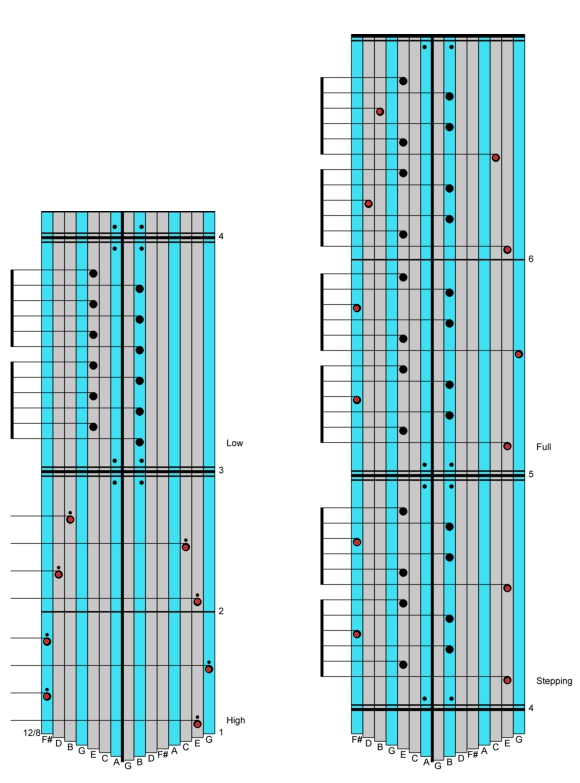When you play kalimba, you should always be willing to accent special melody notes, and let the other support notes come in at a lower volume. Why is this important?
Not always, but often, melody notes will be fairly high in an instrument’s range, and accompaniment notes will occur in the middle or at the low end. A guitar has a three and a half-octave range. The piano has a seven-octave range. On both of these instruments, you have a big difference in the pitch of the melody and accompaniment notes, resulting in the melody and accompaniment parts being easily distinguishable by the ear.
And what about on the kalimba?
The kalimba has only a two-octave range. Sometimes, the melody will be very close in pitch to the notes of the accompaniment. If that is the case, one simple way to distinguish between melody and accompaniment is to accent the melody notes by playing them louder.
In the tablature below – which also can be heard in the media player at the bottom of this tip – we present first the high melody line, then the low accompaniment notes, then a “stepping stone” exercise that begins the process of piecing the melody and accompaniment notes together. Melody notes are filled in with red to help you keep track. The last two measures show the full melody line with two accompaniment notes in between each melody note.

The triple (or double) horizontal lines with two dots below and/or above are repeat signs – each section is demarcated by these repeat signs. Repeat each one or two measure section as many times as you need to, to get a feel for the music.
The easy thing about this music is that it is strictly right-left alternating. Look at measure 5, the full part. The notes go right-left-right-left-right-left-right-left…etc. Yes, the music is fast here, but the easy way to play fast music is to alternate thumbs just like this. The first note, on the right side, is a high note (red) which should be accented, followed by two accompaniment notes which are unaccented. The next high note (red, accented) is on the left side. So, the accent pattern goes: STRONG-weak-weak-STRONG-weak-weak. Because every third note is accented, and the thumbs are strictly alternating right-left, the accented notes change sides regularly, but slowly.
The difficult thing about this music is that there is a really big stretch from the low notes to the high notes, and each thumb (but especially the right thumb) needs to move a long way in going back and forth between high notes and low notes. It is somewhat difficult to both travel the thumbs so far, AND to always remember to accent the high notes and not the low notes. So, as you are piecing this together, go as slowly as you need to. Also, feel free to go back to the high-only and low-only parts – the more you play these easier single parts, the more your brain will just know them without you having to think about them.
The really cool thing about this pattern: the high melody line is very easy, and the low accompaniment by itself is very easy. While it is not too difficult to put them together, the resulting composite pattern is fairly complex. It is sort of like “1 + 1 = 5”. You get a lot more out of this pattern than you put in. Now, that’s kalimba magic!
This is a great pattern that can be used in a variety of situations, and it can be modified for different harmonies and melodies. Feel free to make this pattern your own, and use it in your own songs.
There are more patterns similar to this one in the Advanced Alto Kalimba Download. You are welcome to use them in your songs as well!


Sign up for our newsletter and free resources with your email address:
We pinky promise not to spam you and to only send good stuff.
 Christmas in July 2025
Christmas in July 2025 Patriotic and American Music for Kalimba
Patriotic and American Music for Kalimba